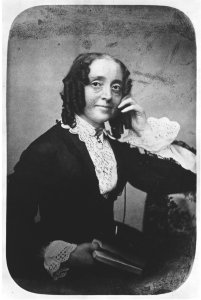At first glance atheism and feminism are two sides of the same coin.
After all, the most passionate criticism of patriarchy has come from religious (or formerly religious) female scholars. First-hand experience of male domination in such contexts has led many to translate their views into direct political activism. As a result, the fight for women’s rights has often been inseparable from the critique of organised religion.
For example, a nineteenth-century campaigner for civil rights, Ernestine Rose, began by rebelling against an arranged marriage at the tender age of 16, and then gradually added other injustices she witnessed during her travels around Europe and the United States to her list of causes.
Rose was born in a Jewish family, and her religious background certainly affected her subsequent life in two distinct ways. Judaism fostered an inquisitive and critical attitude to the world around her, while at the same time making her aware of the gender inequalities in her own and other religious traditions. She went to the United States in 1836 where she soon started to give public lectures on ending slavery, religious freedom and women’s rights. After one of such public appearance, she was described by the local paper as a ‘female Atheist … a thousand times below a prostitute’.
Negative publicity meant that Rose’s popularity grew significantly, although her speeches were met with such outrage that had to flee the more conservative towns. She continued to make appearances at women’s rights conventions across the United States, although her outspoken atheism caused unease to both men and women.
It did not, however, stop her from becoming the president of the National Women’s Rights Convention in 1854. She worked and made friends with other politically involved women of her time, such as Elizabeth Cady Stanton, Susan B. Anthony, and Sojourner Truth. Rose’s atheism was not exactly at the forefront of her struggle for justice but it implicitly informed her views and actions. For example, she blamed both organised religion and capitalism for the inferior status of women.

Well over a century later the number and variety of female atheists are growing. Nonetheless, atheism remains a male-dominated affair. Data collected by the Atheist Alliance International (2011) show that in Britain, women account for 21.6% of atheists (as opposed to 77.9% men). In the United States men make up 70% of Americans who identify as atheist. In Poland, 32% of atheists are female, and similarly in Australia it is 31.5% .
On rare occasions when female atheists appear in the media, they are invariably feminist activists. This is hardly a problem but unfortunately it leads to a conflation of feminist activism and atheism, which in turn makes the ‘everyday’ female atheists invisible. It also encourages stereotyping of the most simplistic sort whereby the feminist stance becomes the primary focus while the atheism is treated as an add-on. But the two do not necessarily go together, and the women may not see them as equally central to their lives.
As significant progress has been made with regard to gender equality, and traditional religion has largely lost its influence over women’s lives, the connection between atheism and feminism has become more complicated.
My current project involves talking to self-identified female atheists from Britain, Poland, Australia, and the United States. Times may have changed but the core values held by these women closely resemble those espoused by Ernestine Rose, and the passion with which they speak about global and local injustice indicates a very particular atheism, far removed from the detached, rational and scientific front presented by some of the famous (male) faces of the atheist movement.
Two themes have emerged. One is the ease with which an atheist identity can be combined with ethics of care and altruism (thus demonstrating the compatibility of non-belief with goodness). Two is discrimination against women within the atheist movement.

The latter reminds me of a paper I once heard at a Gender and Religion conference in Tel Aviv. The presenter compared two synagogues in Paris: a progressive and liberal one which had a female rabbi, and a conservative one which preserved the strict division of gender roles. The paradox lay in the fact that more instances of discrimination against women, including overt sexism and sexual harassment, were reported among the members of the liberal synagogue.
Clearly, nobody looks for sexism in a place defined as non-sexist. A similar paradox applies to atheists. An activist in the atheist community told me that she received the worst abuse from her fellow (male) atheists, not religious hardliners.
One of the explanations for women’s greater religiosity is their need for community, emotional support, and a guiding light in life. Conservative religions perform this role very well, but so do alternative spiritualities where traditional religion is in decline and women suffer from emotional, not material, deprivation.
Atheism does the same for my interviewees. The task of a sociologist is to de-familiarise the familiar and to find the unexpected in the everyday through the grace of serendipity. Female atheists find empowerment and means of expression in their atheism, while at the same time defining it for themselves, rather than relying on the prominent male figures in the atheist community. While on the surface they lack the structure present in religious communities of women, they create networks of support with other women where atheism is but one, albeit a crucial one, feature of their self-definition.
The openness provides a more inclusive and flexible starting point for coming together and fighting for equality and justice, not necessarily on the barricades. Activism is inspiring but values spread more effectively it is in the everyday, mundane activities. In this sense, deeply religious and deeply atheist women have a lot in common. Both find fulfilment and joy in forging connections with other people and creating a safe haven for themselves and those close to them.
The female atheist activists all say the same thing: ‘I do it because I want to help’. A modest statement which can achieve a lot in the long run.
The post Atheism and feminism appeared first on OUPblog.




